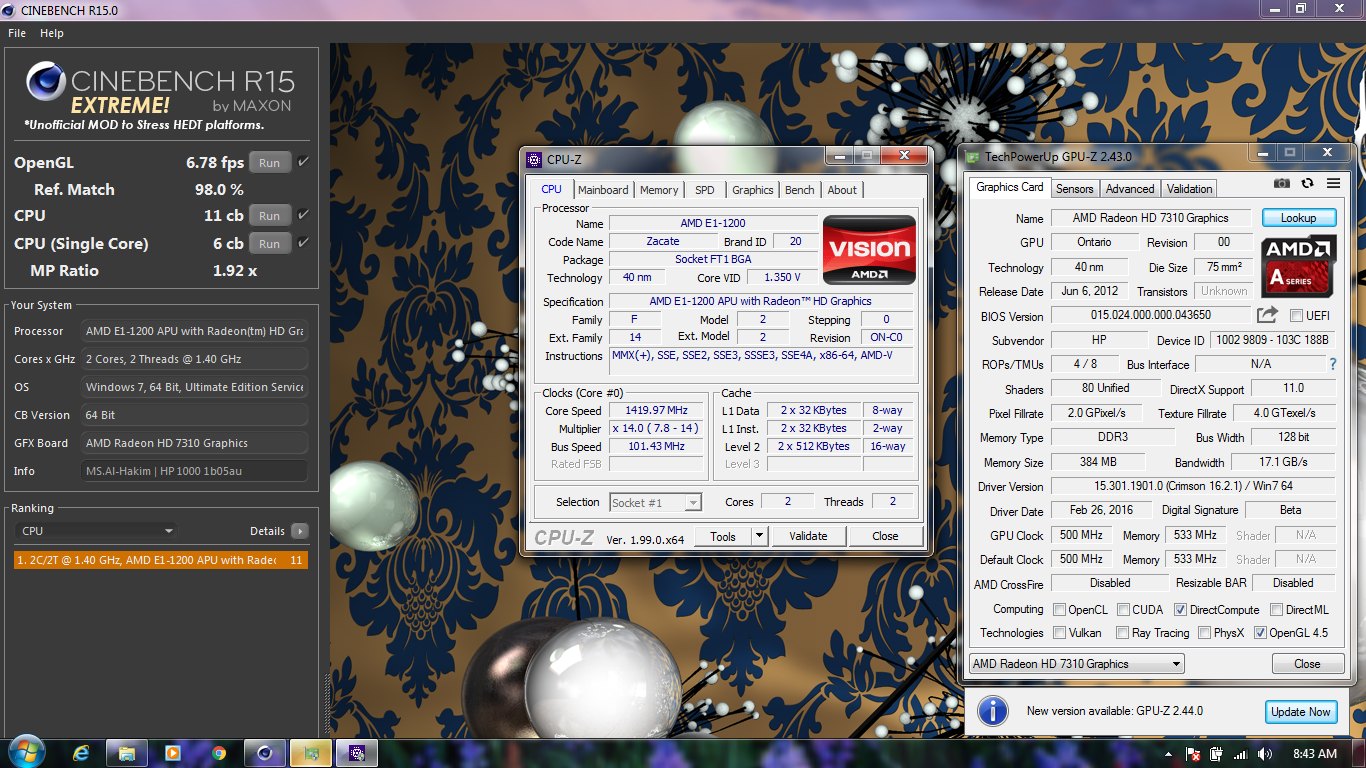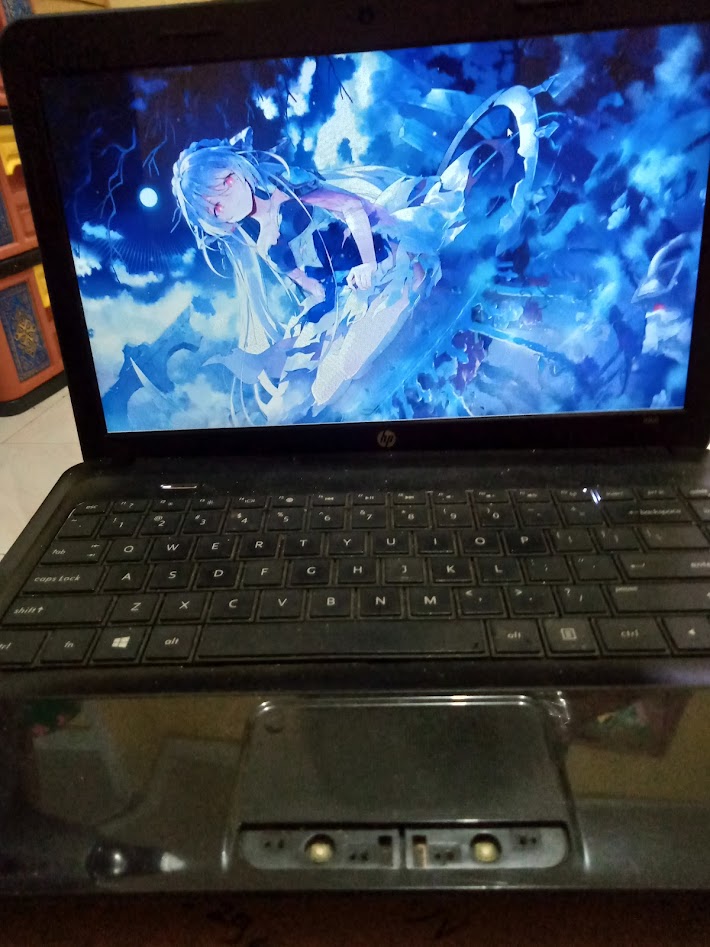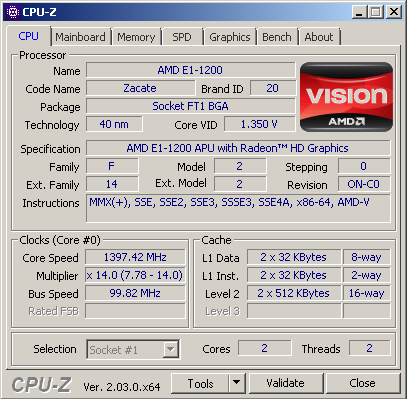Cinebench - R15 EXTREME! Multi Core score 11 cb with a E1-1200
Thursday, 01 January 1970 07:00 | Update at null
Media Gallery
Screenshot

Device, Setup, etc



URL
https://bit.ly/3cyMF0ZInformation Detail
Hardware: AMD E1-1200
Specs:CPUID : AMD E1-1200 APU with Radeon(TM) HD Graphics
Architecture : x86
Codename : Zacate
L3 Cache : -
Clock : 1.4GHz
Core/Thread : 2/2
TDP : 18W
Technology : 40nm
Socket : FT1 BGA 413-Ball
IGPU : AMD Radeon HD 7310
See more specification...
Software: Cinebench - R15 EXTREME! Multi Core
Score: 11 cb
About: Cinebench - R15 EXTREME! Multi CoreCinebench R15 EXTREME! – Multi Core is a modified version of the classic Cinebench R15 benchmark designed to more accurately test multi-core CPU performance in the era of modern processors with extremely high core counts. This benchmark was developed to address the limitations of the standard Cinebench R15 version, which was originally designed when 4-core processors were still the industry standard. Now, with the advent of CPUs featuring 16, 32, or even 64 threads, the standard Cinebench R15 completes too quickly, resulting in scores that do not accurately reflect actual performance in long-term workload scenarios.
This EXTREME! version was developed unofficially by the enthusiast community, including members of the Guru3D forum, by modifying the benchmark's render resolution to four times that of the original version. This change imposes a significantly heavier and longer workload, preventing the rendering process from completing in just a few seconds. With a longer processing time, features like thermal throttling and automatic clock speed reduction on the processor can be more realistically represented, yielding scores that are more representative of CPUs with multiple cores.
Cinebench R15 EXTREME! – Multi Core continues to run the same photorealistic 3D scenes as the standard version, utilizing the advanced rendering algorithms of the CINEMA 4D engine. However, with increased complexity and render resolution, this benchmark is more relevant for workstation-class CPUs and enthusiasts who have high parallel processing capabilities.
It should be noted that Cinebench R15 EXTREME! is an unofficial version, a modified version of the original software owned by Maxon. Although it is not distributed or supported directly by Maxon, this benchmark has been well-received by the community for its ability to provide more credible results in measuring multi-threaded CPU performance at the high end. For users who want to truly test the limits of their system's performance, especially for rendering, scientific computing, or other professional workloads, Cinebench R15 EXTREME! is a highly useful testing tool.
Released in 2012 as part of the Brazos 2.0 family, the AMD E1-1200 is a power-efficient processor aimed at entry-level laptops. It has a 2 core and 2 thread configuration with a fixed clock speed of 1.4 GHz, with no support for Turbo Core technology. Built with a 40nm fabrication process, the E1-1200 has a TDP value of 18 watts-efficient enough for portable devices that emphasize low power consumption and longer battery life. Despite its limited performance, the E1-1200 was a popular choice in its day thanks to its affordable price and ability to handle light computing needs.
One of the main advantages of the AMD E1-1200 is the integrated Radeon HD 7310 GPU, which offers better graphics performance than Intel's entry-level graphics solutions at the time. This GPU has the ability to play HD resolution videos smoothly, as well as run light games such as Counter Strike 1.6, Plants vs Zombies, or other casual games with minimum graphics settings. That said, this combination of CPU and GPU is not intended for heavy-duty work such as video editing, 3D rendering, or modern gaming. Overall performance is more optimal when used for tasks such as browsing, streaming videos, accessing social media, typing documents, as well as basic office applications.
However, it should be noted that the AMD E1-1200 is less suitable for heavy multitasking, especially in modern operating systems like Windows 10. With a low clock speed and no Boost feature, users may experience lag or limitations when opening multiple applications at once. In tests using the HP 1000 1b05au laptop, this processor was paired with 4GB DDR3 single channel RAM (2 DIMM slots) and tested on Windows 7, Windows 8, and Windows 10 operating systems. The results show that the most optimal performance is achieved on Windows 7 or Windows 8, while in Windows 10 the system tends to be slow although it can still be used for basic needs. As such, the AMD E1-1200 can still be relied upon as a power-efficient and inexpensive solution for users with very light computing needs.
Hardware Detail:
Device: HP 1000 1b05au
RAM: 4GB DDR3 Single Channel 2 DIMM
OS: Windows 7, Windows 8, Windows 10
* Not Avaiable
